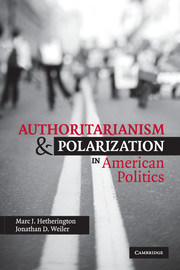Book contents
- Frontmatter
- Contents
- Acknowledgments
- 1 Spanking or Time Out: A Clash of Worldviews?
- 2 Putting Polarization in Perspective
- 3 Authoritarianism and Nonauthoritarianism: Concepts and Measures
- 4 A Historical Account of the Roots of Worldview Evolution
- 5 Authoritarianism's Structuring of Contemporary Issues
- 6 Threat and Authoritarianism: Polarization or Convergence
- 7 Evidence of Worldview Evolution
- 8 Immigration: A Reinforcing Cleavage that Now Constrains the Republican Party (GOP)
- 9 What the 2008 Democratic Nomination Struggle Reveals about Party Polarization
- 10 A New View of Polarization
- Epilogue
- Bibliography
- Index
3 - Authoritarianism and Nonauthoritarianism: Concepts and Measures
Published online by Cambridge University Press: 05 June 2012
- Frontmatter
- Contents
- Acknowledgments
- 1 Spanking or Time Out: A Clash of Worldviews?
- 2 Putting Polarization in Perspective
- 3 Authoritarianism and Nonauthoritarianism: Concepts and Measures
- 4 A Historical Account of the Roots of Worldview Evolution
- 5 Authoritarianism's Structuring of Contemporary Issues
- 6 Threat and Authoritarianism: Polarization or Convergence
- 7 Evidence of Worldview Evolution
- 8 Immigration: A Reinforcing Cleavage that Now Constrains the Republican Party (GOP)
- 9 What the 2008 Democratic Nomination Struggle Reveals about Party Polarization
- 10 A New View of Polarization
- Epilogue
- Bibliography
- Index
Summary
Thus far, we have introduced why we think authoritarianism is central to an understanding of the contemporary political divide, particularly in regard to the polarization of U.S. politics in the early twenty-first century. In this chapter, we explain in more depth our understanding of the concept of authoritarianism itself. Recognizing the implications that the term has had in the literature, we define and defend our use of it, and explain how more recent innovations in measuring the concept lend themselves to a better understanding of its utility in explaining crucial features of the contemporary American political divide. Finally, we consider nonauthoritarianism as a distinct worldview with particular attributes of its own. Up to now, nonauthoritarianism has been largely seen as a default category, which we believe is mistaken. In fact, much of the explanatory power of authoritarianism in understanding contemporary political conflict derives from changes in attitudes among nonauthoritarians.
We should note at the outset that when we define authoritarians and non-authoritarians, we are dealing in ideal-typical categories. Many Americans are near the midpoint of the scale, not obviously evincing more characteristics of one category than the other. And even those at the extremes may, in some ways, maintain beliefs and attitudes more typical of the opposite extreme. In other words, we do not assume that most Americans are two-dimensional caricatures one way or the other. Instead, in this chapter, we sketch the ideal types in order to specify the attributes that we think are most relevant.
- Type
- Chapter
- Information
- Authoritarianism and Polarization in American Politics , pp. 33 - 62Publisher: Cambridge University PressPrint publication year: 2009
- 1
- Cited by



